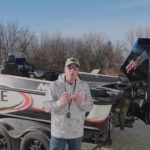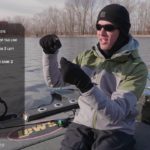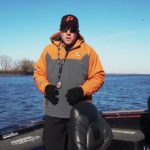The Pursuit of Big Pike
The Pursuit of Big Pike
By Jason Mitchell
The black Dacron line slid through my gloves as it sliced back and forth in the hole. Every time the fish came close to the bottom of the ice, the fish rolled and ran. The power was untamed and unpredictable. There was no doubt that a big pike was on the end of the line but that assumption was confirmed as the long shadow slid underneath the hole. As the fish rolled closer, water rose up and down in the hole, the telltale sign of serious water displacement. Big fish move water and this was a big fish.
For so many ice anglers, pike provide that thrill… the thrill of catching a large powerful fish. Pike are a top of the line predator with dangerous teeth and an attitude to match the intimidating appearance. When pike surpass the benchmark of forty inches in length, the not only aspire awe but they can be a downright handful. A beautiful challenge and photo op for any ice angler.
Big pike can be specifically targeted on many bodies of water right now and the late ice window might be one of the most coveted prime time opportunities for seeing some of the biggest pike each season. Prime locations right now combine big fish opportunities with open seasons for specifically targeting these species. Top locations include Lake of the Woods and the big reservoirs on the Missouri River like Fort Peck, Lake Sakakawea and Lake Oahe right now. Other notable picks include Devils Lake and Red Lake but there are many more obscure fisheries particularly on smaller lakes that offer great pike fishing at late ice. If I had to pick a top pike region right now with big fish capabilities, I would lean towards the Missouri River reservoirs of Fort Peck, Sakakawea and Oahe. These reservoirs were rejuvenated with strong year classes of pike almost a decade ago from high water and these reservoirs all boast impressive numbers of quality fish with big fish potential. If your quest is to crack a big pike, fish these prime locations at prime time.
What makes late ice so attractive for pike anglers is that these fish concentrate in predictable locations. The larger bays in the Missouri River reservoirs all have pike populations. Typically, most of the big pike are caught at late ice in the back 1/3rd of the bay. As a general rule of thumb, nice warm weather that thaws and moves water into the backs of these bays will typically pull fish shallow where as cold fronts will push the fish deeper into the channels. A few years back, Jason Votova and myself filmed an episode for our television show in the back of Douglas Bay on Lake Sakakawea. Votova likes to set out tip ups perpendicular across the creek arms and bays to intersect pike as they push in and out of this location. Instead of following a specific contour, Votova maintains that he contacts more pike by cutting across the bay perpendicular with holes so he has baits set at different depths. Some days, the fish might follow a ten-foot break as they slide up the tributary. Other days the fish might be running deeper or shallower, this mentality and hole placement puts more bait in front of fish as they move.
Jig rods catch pike. Swim baits and large flutter spoons can do a number on pike but day in and day out, there are few things that can rival dead bait below a tip up. Classic Beaver Dams are still one of the best. Pair the tip up with the heaviest Dacron line you can find. Many serious big pike fanatics will use forty pound or heavier Dacron. The reason for the heavy Dacron is two fold; handling big fish but the heavier line also rolls off the tip up spool much smoother and doesn’t slice into the bottom of the ice or your hands as much.
Still one of the best rigs for catching large pike is a simple steel or titanium leader with a snap connected to a large size (###) treble hook. Unsnap the hook and push the eye and shank of the treble through a large dead smelt, herring or alewife. After the eye of the hook is pushed through the bait, snap the treble hook back on to the leader. This causes the bait to ride horizontal and the larger hook has a better gap and penetration particularly when dealing with large pike. Less can also go wrong with one big hook, as you don’t have a second hook getting caught on the ice when fighting a fish at the hole. Quick strike options that use multiple hooks are also popular and are often the answer when fish start short striking the bait or won’t run with the bait. Top quick strike rigs include the Bigtooth Tackle Quick Strike Rigs made by Clam Pro Tackle.
Big dead baits typically catch the biggest fish. Smelt are often the most popular and easiest to find but attempt to use baits that are at least eight inches or longer. The advantage of smelt is that they are soft and bend easy in the mouth of fish so the batting average can be much higher with smelt. Some other baits like frozen anchovies and herring however seem to have much more oil and smell and often get more bites. Big dead baits can sometimes be challenging to find so you might have to order them in bulk from a commercial fish distributor on either the east or west coast.
While the big dead baits are usually the best bet, there are situations where downsizing produces more hook ups. There are times especially when dealing with really thick ice where the resistance at the bottom of the ice as fish peel off line produces enough friction where fish will drop the bait. There are also some situations where the fish are running and than dropping the bait because of the line hitting flooded vegetation and debris. Small pike will also often drop big dead baits prematurely. If you are getting flags but just cannot connect or the fish are repeatedly no longer on the bait when you get to the tip up, go down to half a dead bait and try to stick them sooner without waiting.
A few additional tips for targeting the biggest pike of the ice season. Warm weather increases the amount of runoff and flow into the back end of these major spawning bays and tributaries. If water is moving up and down in the hole, you have water moving. Also watch the shorelines and look for thaw as water seeps into the ice.
Typically, this thaw will stain the water and improve the bite dramatically as you work towards the far back ends of these bays. Cold nights and fronts can often halt this process so typically where the fish set up is influenced by incoming flow. When the water starts to move, we often find fish shallower and further back. When the water is not moving, focus on the sharper breaks and slightly deeper water towards the secondary points within these bays.
While pike are fairly abundant across the ice belt and provide ample opportunities, big pike are a special fish and are not as common. Not only does it take the right water to grow big pike but a pike also has to live long enough to reach that trophy status. Pike are such gluttonous predators that we often see big pike fisheries develop because of remoteness where fish can avoid angling for large time frames without getting caught. As a result, catch and release is crucial for preserving big pike fisheries. In order for a pike to measure forty five inches long in most bodies of water in the lower 48, that pike was probably released when the fish was 36 inches, again when it was 40 inches and so on.
Think of good pike releases much like musky angling today. Have your release tools handy. Keep the fish in the water until you can unhook the fish. Pose with a nice picture and get the fish back in the water. There are few moments in ice angling like watching a fish as large and powerful as a forty inch plus pike wave you good by as that big powerful tail kicks as that fish swims away. This season, make some of these memories for yourself and feed your fascination for big fish with these fascinating predators.





